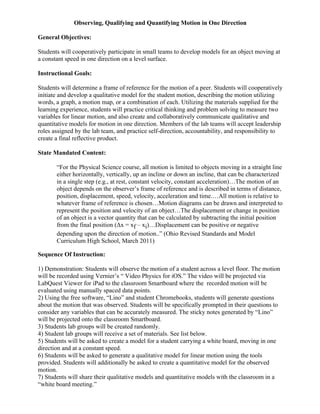
Modeling and Measuring One-Directional Motion
- 1. Observing, Qualifying and Quantifying Motion in One Direction General Objectives: Students will cooperatively participate in small teams to develop models for an object moving at a constant speed in one direction on a level surface. Instructional Goals: Students will determine a frame of reference for the motion of a peer. Students will cooperatively initiate and develop a qualitative model for the student motion, describing the motion utilizing words, a graph, a motion map, or a combination of each. Utilizing the materials supplied for the learning experience, students will practice critical thinking and problem solving to measure two variables for linear motion, and also create and collaboratively communicate qualitative and quantitative models for motion in one direction. Members of the lab teams will accept leadership roles assigned by the lab team, and practice self-direction, accountability, and responsibility to create a final reflective product. State Mandated Content: “For the Physical Science course, all motion is limited to objects moving in a straight line either horizontally, vertically, up an incline or down an incline, that can be characterized in a single step (e.g., at rest, constant velocity, constant acceleration)…The motion of an object depends on the observer’s frame of reference and is described in terms of distance, position, displacement, speed, velocity, acceleration and time.…All motion is relative to whatever frame of reference is chosen…Motion diagrams can be drawn and interpreted to represent the position and velocity of an object…The displacement or change in position of an object is a vector quantity that can be calculated by subtracting the initial position from the final position (Δx = xf – xi)…Displacement can be positive or negative depending upon the direction of motion..” (Ohio Revised Standards and Model Curriculum High School, March 2011) Sequence Of Instruction: 1) Demonstration: Students will observe the motion of a student across a level floor. The motion will be recorded using Vernier’s “ Video Physics for iOS.” The video will be projected via LabQuest Viewer for iPad to the classroom Smartboard where the recorded motion will be evaluated using manually spaced data points. 2) Using the free software, “Lino” and student Chromebooks, students will generate questions about the motion that was observed. Students will be specifically prompted in their questions to consider any variables that can be accurately measured. The sticky notes generated by “Lino” will be projected onto the classroom Smartboard. 3) Students lab groups will be created randomly. 4) Student lab groups will receive a set of materials. See list below. 5) Students will be asked to create a model for a student carrying a white board, moving in one direction and at a constant speed. 6) Students will be asked to generate a qualitative model for linear motion using the tools provided. Students will additionally be asked to create a quantitative model for the observed motion. 7) Students will share their qualitative models and quantitative models with the classroom in a “white board meeting.”
- 2. 8) Students will be asked to evaluate the similarities and differences of the generated qualitative and quantitative models created by each lab group. Note: since there was no clear teacher directive concerning the required nature of the model to be developed, student models may likely vary, including written explanations, motion maps, graphs, and equations. Materials: Meter stick, string, tape, dry erase marker set, two whiteboards, LabQuest 2, motion detector, LabQuest 2 manual, electrical receptacles, classroom chairs, white board erasers, iPads, Chromebooks. (The student iPads do not support the Video Physics for iOS software.) Safety Considerations: Students will potentially be using electrical cords in this activity. Proper use of plugs and receptacles will be required. Students may choose to gather data outside the classroom. Appropriate respect for the free passage of other students must be observed. Assessments and Outcomes: 1) Students will generate questions concerning the motion of a spherical via “Lino” sticky notes. 2) Students will create and share a labeled qualitative model via white board. 3) Students will create and share a labeled quantitative model and explain how the model can be used to measure motion of other objects. 4) Student groups will create a lab report using Google Docs. 5) Students will demonstrate observable and measurable relationships by creating an appropriate model. 6) Students will participate in sharing their models in a group setting. 7) Students will determine a frame of reference for motion. 8) Students will describe motion as positive or negative with regard to the frame of reference. 9) Students will utilize the tools provided to gather data and create models for motion. 10) Students will cooperate in gathering, sharing and evaluating data. 11) Students will practice accountability to complete all team-generated assignments. Rationale: Students have all observed motion in multiple venues. Students may or may not have pre- existing vocabulary to describe variables that are related to motion. In this activity, students will be given independent choice to develop models for motion using varied tools provided for the activity. Students will need to consider the differences between a qualitative model and a quantitative model, and also determine how a quantitative model is predictive of the data that will be recorded in a qualitative model. Creating and utilizing appropriate graphs, students will be required to utilize Google Docs to successfully compose a group lab report. The lab report format draws on student previous experience with scientific thinking and usage of the scientific method to form and test conclusions. Use of the LabQuest 2 technology and motion detector will depend on student choice. Students will gain valuable experience in describing constant motion with respect to measurable variables, building on previous experiences in elementary and middle school. Students will be empowered to transfer the understanding of variables in constant motion to other settings.